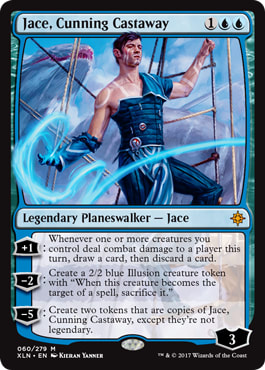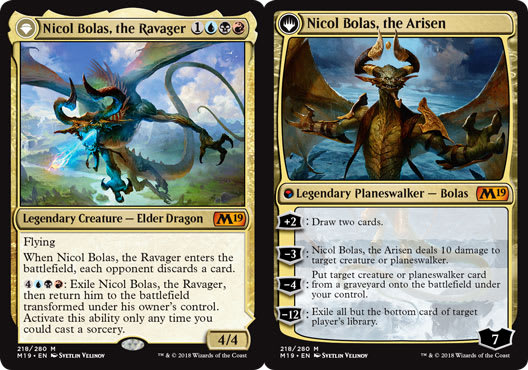The longer I spend actually analyzing media, the less I trust universal claims of how things should or shouldn't work. Maybe this is me descending inexorably into the gravity well of my own navel due to way too much *Theory*, but I dunno, it's just getting harder and harder for me to take seriously approaches to art that rely on either mechanical absolutism or a kind of flattening mysticism that proposes all stories are merely reflections of some vaster archetype. Most Grand Narratives these days leave me cold and windswept, and I'm hunkering down for warmth in specificity.
Dominaria looks back and looks forward, a nexus within a shared-world serial narrative that's been going on for nearly a quarter century. Sometimes these castings back and forth in time work. Sometimes they don't. That's probably ok! The same tool isn't necessarily applicable to each situation.
In general I'm suspicious of retcons in serial narrative. Rather than the dynamics of anticipation and fulfillment or frustration that I talked about in previous articles, they form a kind of fissure in the narrative, a clean and unexpected break. Unless . . . they don't! Serra originally dies because she's so broken up about Feroz's death that she allows herself to be killed by a random thief planeswalker. In the revised version of this narrative constructed by Kelly Digges and Ethan Fleischer, Serra does something more like Bo Levar and Lord Windgrace, pouring her magic into the land of Sursi to help the people there . . . after getting shanked by a random thief planeswalker. It's not a HUGE change, but it is a change.
It's a retcon that functions not as a fissure but as a bridge, and a reframing of Serra's overall narrative, going from a kind of depressing one where she continuously runs away from things that make her sad until she dies, to one where eventually she takes a stand in Sursi and, like her beloved Feroz, uses her power to protect a vulnerable people. This alters the future as well, allowing for a place on Dominaria where Serra Angels spontaneously generate.
The fact that such a minor retcon can have such a major effect on both the past and future of a narrative is exactly why it's so easy for serial narrative to go off the rails.
Let's return again to the furor over Jace's brief scene in Dominaria and its discontinuity with that same scene's portrayal in Ixalan. In Ixalan, Jace hones onto Gideon's presence and manages to planeswalk onto the Weatherlight, Gideon bursts into the room where Jace appears and Jace greets him breathlessly, enthusiastically. And Gideon, meanwhile, is described from Jace's perspective: "His expression was overcome with emotion. This was someone who was happy to the point of tears to see that he was alive. This was a friend."
In Dominaria, of course, none of that happens, and Jace and Gideon share a surprisingly impersonal greeting. The scene also extends beyond that point, introducing Liliana, who Jace reacts understandably coldly to, but it's that first part I'm interested in. I'm interested in its disconnect from the former version of the scene, and how readers (both readers in the fandom and the readers within WotC whose "word of god" acts as official interpretation) have filled that gap.
Ixalan Jace is, ostensibly, Jace moving forward, according to that official word. But what about Dominaria Jace? One could claim of course, as has been the WotC line in the last few weeks, that Dominaria Jace is just Ixalan Jace "not pleased to see Liliana." That's a way to patch that, I suppose. But Jace's attitude toward Gideon is profoundly different in a way that I found shocking. There are two texts here, not one. To what degree will what text be relevant moving forward? Specifically, when we as readers encounter Jace and Gideon in the future storyline, to what degree should each of these different scenes affect our reading?
I think this question provokes a lot of anxiety in some readers. For others, mind, it might just be part of the fun. Jared Gardner, in Projections: Comics and the History of Twenty-First Century Storytelling discusses at length the way early serial comics and films deliberately existed in this uncertainty space. Part of the engagement was, and still is, the question of just what will happen next, and for early film this was mixed in with the presence of multiple cuts of each serial played at individual theaters with their own on-staff re-editors. Fandom engagement here was partly piecing together what versions of the narratives should be most important.
However, that engagement isn't all necessarily an engagement of attention and joy -- it'd be silly to assume that the only emotions provoked by these kinds of games are positive ones! Even the early comic creators learned that: Gardner reports that the creator of early newspaper strip "The Gumps" received haranguing mail demanding that he actually resolve some plot hooks, rather than simply adding "a veiled face" anytime he "gets a little short of material". For people like me very invested in the Jace and Gideon who are moved to tears at the sight of each other alive and well, the anxious question of which scene will be used moving forward provokes attention, to be sure, but also fear or even anger about a bad projected future storyline. Moreover, these feelings cannot be resolved until more story appears, months or even years down the line. That's the price and the dark side of serial pleasures.
What was gained by that price? Um. Not a lot. I mean, look, I'm just not sure what this "interpretation" of the scene actually does for the narrative. I think I can see what it's supposed to do within the context of the story Wells is telling about Liliana. This seems to be a tragedy in which someone who's spent a lifetime exploiting and abusing other people tries to get better and banish her demons (fantasy: making the figurative literal!) only to find that she can't escape her past actions, and no one believes enough in her attempts to change to come to her aid.
Wow, when you lay it all out like that this is actually a pretty damn grim story, isn't it? While everyone else is celebrating the triumph over the Cabal and the comradery of being the new heroes of the new Weatherlight, she's dragged off to serve a genocidal monster, abandoned because she can't do enough to be forgiven. That's horrifying! And Jace's response to Liliana lines up with that horror: this person she's had wrapped around her finger for years now sees her solely as a villain, and it doesn't take much for him to persuade Gideon that she's just an irredeemable person.
Wouldn't it have been more of a gut punch, and more of a prelude of what's to come, if Jace's tearful, joyful meeting with Gideon had been preserved? Wouldn't it have been more affecting if Jace's new, less traumatically burdened personality suddenly slammed shut again the moment Liliana walked into the room and all his defense mechanisms got triggered?
Like, it's not that I think Jace should be enthusiastic about meeting the person who exploited him. I just have a better version of the scene to hand. I have struggled to make sense of the logic of this different interpretation and the conclusion I've come to is that it was just an artistic misstep.
This is the other price of this kind of uncertain seriality: the possibility that if two versions of a story coexist, one might just be straight up better than another.
There's a lot of uncertainty to Dominaria, as a whole. We have a lot of setup for future plot events, but there's not a ton of change in, for example, the crew of the Weatherlight after they initially find their place on the crew. By the final battle, everyone's pretty much just doing their appointed thing . . . except Slimefoot, whose capabilities really do bloom in a surprising way. While this does helpfully underscore how great Slimefoot is (good fungus, best friend) it felt a little frustrating.
Dominaria leaves me wanting more. That's a good thing in some senses. Obviously, despite my criticisms of some aspects of the story's execution, I find plenty to love in these characters. Wells does an excellent job of bringing to life the Weatherlight's new crew, Liliana's story is grim but in an interesting way, and Teferi's ongoing struggles are captivating. And yet . . . it feels like much of the present pleasure is really a pleasure in an imagined future, and that can actually be a pretty risky thing for serial readers to buy into.
As I write this, we're finally getting the story of the Elder Dragon War. This is awesome, all the more so because it came completely out of left field. I never thought they'd do something like this. For goodness sake it's been 20 years! And so far Kate Elliott has done a fascinating job bringing it to life, in ways that I never expected. It turns out that the Elder Dragon War was pretty much a sordid colonial scramble. That's . . . not what I expected! And for me, the breaking of that expectation, and the bad feelings it provokes, are exactly what makes this storyline so interesting, prompting the same kind of re-examination that Martha Wells's interpretation of Teferi did.
But how satisfying is it for folks who've waited 20 years, I wonder?
We could look to the way Dominaria ties together a head-spinning range of old storyline materials and feel confident that these new plot threads, too, will have their day . . . but we might have to wait a quarter century to see it, and many of the people instrumental in Dominaria's interconnected worldbuilding and plotting do not work in this department of WotC anymore. (It's not the first time that's happened.)
Wizards of the Coast is engaged in a particularly risky juggling act right now where they're hinging quite a bit on their investment in ongoing serial narrative and franchise development, selling their brand based on the promise that following along will pay off . . . someday. In this sense, the way Dominaria and the Elder Dragon War storyline fulfill the past is not just narratively satisfying but also strategically useful, a kind of proof that they can deliver. At the same time, though, this emphasis on the past and future means that breaks and missteps that affect our reading of the past and projection of the future stand out all the more.
In final assessment, I think Dominaria more than anything else is a fascinating case study: at its heights, it's an amazing example of the incredible things you can do with serial narrative. When it falls apart, it demonstrates how serial narrative and its techniques can become snares. This assessment, though, is by nature open-ended. That's part of the joy and exasperation. We can either look to the future . . . or we can close the book.
























